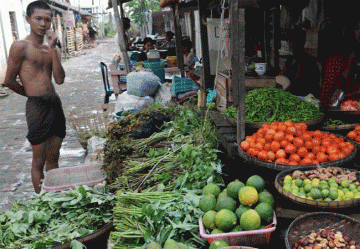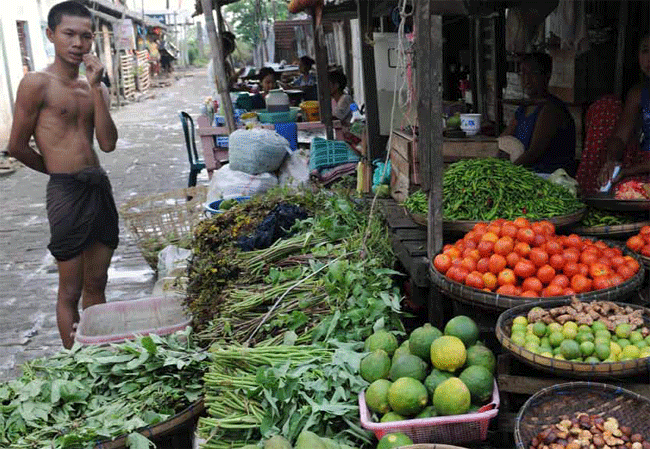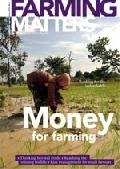
As in many other countries, smallscale farmers in remote rural areas in Uganda are hardly served by banks or financial institutions, and are commonly described as “unbankable”. The reasons given are that they are hard to reach (geographically), that they have little or no collateral, and that they are involved in rather risky activities.
The advent of microfinance has shown that lending money to smallscale entrepreneurs can have very positive results. But most of these programmes focus on urban areas. Other alternatives, like the popular savings and credit co-operatives (SACCOs), have equally excluded many poor rural people as they do not have the money with which to buy shares and become part of such financial programmes. In addition most of the government programmes which are specifically meant to help small-scale farmers in remote areas are strongly influenced by political and social connections – a kind of social capital that the majority lacks.
But all villages have local resources, even if just a few. Can a rural finance programme be based on them? Do rural villages in isolated areas have the possibility of raising their own funds and using these funds for loans? AFARD, the Agency for Accelerated Regional Development found some positive answers to these questions.
Some farmer associations are developing new fundraising activities, while others are improving what they were already doing. Photos: Alfred Lakwo
Changing the financial landscape
AFARD is a non-governmental organisation working in the West Nile Region of Uganda, some 400 km north of the capital, Kampala. Having worked for several years with local development projects, AFARD workers realised that very few money lenders work in remote villages, and that rotational credit schemes involve only a small number of people.
In most cases, microfinance institutions only provide “booster” instead of “start-up” loans, which is what poor people mostly need. And because they lack collateral and business plans they cannot access these loans from commercial banks. But farmers need capital: they need to buy seeds or inputs, the average cost of which has been estimated as approximately 500,000 Ugandan shillings (circa 200 euros) per family per planting season. How to close the gap between demand and supply? AFARD thought of trying a collective approach for all members of the community, not only those with established businesses. The optimal strategy had to be one that built on the existing solidarity between the poor (social capital) and on local possibilities for raising funds – even if this would only result in a small loan portfolio. Such an approach would provide equitable local access and ownership of the loan funds, with all participants making an equal contribution and receiving equal benefits.
During the first months of 2009, AFARD carried out a brief study in three districts of the West Nile Region (Nebbi, Arua and Yumbe). The study focused on the different strategies which the various village associations already used to raise funds. Some farmers’ associations were raising funds by requesting mandatory fees (membership fees, annual subscription fees and monthly subscriptions), others through regular sales of labour, or the sale of specific products (like bricks and firewood). It was thus clear that many farmer associations did have ways of raising funds. These findings were shared among the groups, many of whom began to work out new ideas and went on to start, or further develop, their fundraising activities.
Naturally, there were many differences between these groups. In some cases, AFARD helped with the formal constitution of village associations (generally building on existing ties and relationships). In others, the groups developed internal regulations and working rules. All the groups managed to work out new initiatives. Three months after the first meetings, the associations had accumulated up to 3 million shillings (about € 1,200) and were ready to lend money through their own Group Loan Schemes. To help use these funds effectively, AFARD helped design a credit lending policy. This was reviewed by all the association members and finally adopted as the internal working guidelines. These regulations covered issues such as the approval of a loan, the loan period, interest rates, repayment modes, the fines to be imposed for delayed repayment without acceptable reasons, loan rescheduling in cases of death or sickness of a household member, and the termination of access to loans for anyone declared a bad debtor.
Steps to establishing a Group Loan Scheme
Start by establishing a large group (more than 50 members); focus on building leadership and on team work – but above all involve all members in all the planning work.
Consider what measures for mobilising resources are feasible and acceptable to the community.
Ensure that all group members approve the use of the funds generated for loans, regardless of the size of these funds. Their use should coincide with the process of setting up a transparent and fraud-free guideline and the establishment of a loan committee that ensures compliance with the guidelines.
Make sure that regular supervision takes place, ensuring that guidelines are followed, that accurate and timely reports are provided to members, that bad debtors are excluded, that all records are kept and are accessible to members.
New opportunities
By the end of 2009, AFARD was working with 46 village associations, covering 4,271 households, all running their own Group Loan Schemes. These were circulating a total of 190 million shillings (about € 80,000) in the region, with more than 2,800 borrowers. Overall, in one year of working with the groups, the total money lent reached a total of 384 million shillings.
These loans provide a window of hope. Families are able to buy hand hoes, seeds or ingredients for making organic pesticides, all of which are used to boost production. In only a few months, many families increased the area with crops that sell well, such as cassava.
There has also been a significant change in the perception of farming, as Mrs. Betty, a member of the Yiba group, explains: “With the loan I got from our group, I could increase my groundnut production. The high yield earned us enough money, so that our family was able to have a peaceful Christmas celebration. Everyone had a new dress.” For her, farming is no longer a subsistence venture, but a commercial enterprise.
The loan period averages two months, the interest rate charged is 10 percent per loan period, and there is a very high repayment rate (97 percent). While this interest rate is high, compared to the rates charged by formal microfinance institutions, members of the 46 groups insist that it is necessary in order to increase their loan portfolio. They also continue with their diversified resource mobilisation strategies, such as membership fees. Likewise, many groups are now collectively investing in profitable crops like Irish potatoes, and are cultivating larger areas and aiming at local markets. Some have also taken on value-addition activities by processing maize into flour and de-husking rice for sale.
Reaching “the unbankable”
Tapping into local resources and providing loans with the funds is also having other knock-on results. Both men and women are now involved in new businesses. This is different to how it was before, when women mostly grew food crops and men “robbed” whatever extra money women raised themselves. Such a change has been enabled by an increasing blurring of the distinction between food and cash crops. Women have entered the market economy, and now sell food crops and keep their earnings. Household access to credit has enhanced joint farm planning. Women prefer to grow marketable crops that they can sell and repay the loan. Women keep the rest of the money they earn to meet home needs and to further improve their farming activities.
Seeing that farming can be a profitable business also makes many youngsters feel less attracted to the cities. At the moment, youths constitute on average 14 percent of the membership of all groups supported by AFARD. Aware of unemployment and hardships in urban areas, many youths have taken up farming as a productive venture from which they can generate incomes, improve their livelihoods and gain social status; something they had lacked for decades. Access to credit and organisational strengthening of youth groups have played an important role in realising this.
Another important aspect of the approach is the “democratisation” of credit. All farmers who belong to a group automatically qualify for a loan, given that all of them have made equal contributions to the loan fund. They all pay the same amount of membership and subscription fees and provide the same farm labour (except in the case of bad debtors, those who twice fail to repay a loan without acceptable reasons). And many associations are using part of their profits (up to 7 percent) to support people living with AIDS and orphans.
A bottom up approach
There is little doubt that having money to invest plays a critical key in reducing poverty. Poor farmers need cash in order to improve their farming practices and livelihoods. It enables poor farmers to set up small businesses (of a size their local markets can handle) from which they can increase their incomes and even accumulate assets (bicycles, cows or a radio). Access to credit has changed the way smallholder farmers see agriculture and the strategies they follow – they are able to select better varieties, plant early, and stick to sustainable practices. While the results need to be measured more clearly, there seems to be a preference for organic pesticides, better soil management and conserving local biodiversity.
All this shows the huge and untapped (and often ignored) potential that there is for small-scale farmers to raise funds locally. This is true microfinancing from below: an effective alternative to approaches that are based on the idea that poor people know nothing about money or how to manage it. Well used, this approach can help build attitudes of self-reliance and develop sustainable farming practices.
Text: Alfred Lakwo
Programme Director at the Agency for Accelerated Regional Development (AFARD).
E-mail: alfred.lakwo@gmail.com,
Photo: Folkert Rinkema


